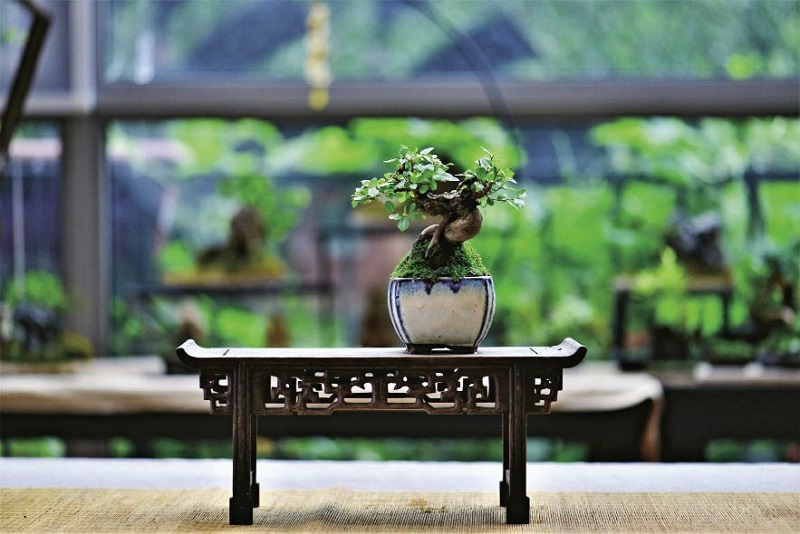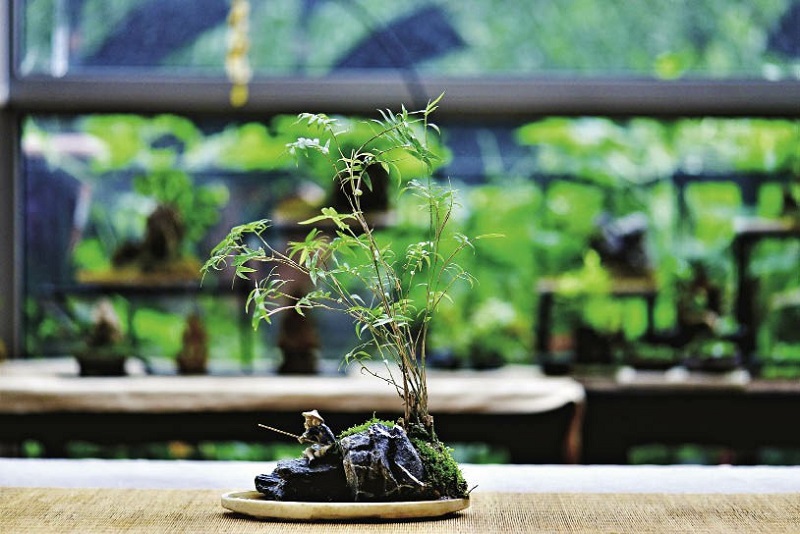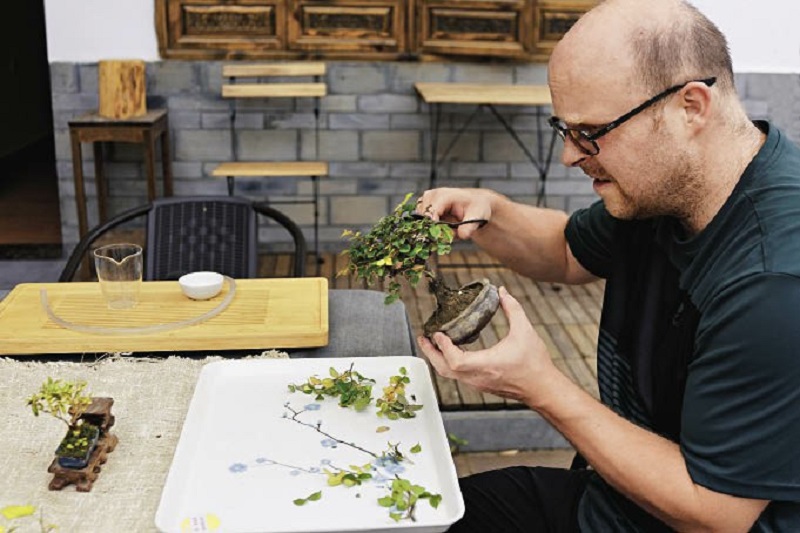
Chad Sinclair is quite adept at making good use of local plants and stones in Sichuan to create bonsais.
Inscribed on the National Intangible Cultural Heritage List, the Sichuan-style bonsai has attracted a particular enthusiast: Chad Sinclair from Canada. As a musician, teacher, and bonsai artist born in Vancouver, British Colombia, the 42-year-old has lived in China for 17 years. Recently, he moved his bonsai studio from downtown Chengdu, Sichuan Province, to Yanjiawanwan in Chongzhou, a county-level city under the jurisdiction of Chengdu. The move has helped him immerse himself more in the study of Sichuan-style bonsai. As he likes to be called Bai Xiong (polar bear), he calls his studio the “Baixiong Bonsai Garden.”

Bamboo, one of the most common plants in Sichuan, is often featured in Chad Sinclair’s bonsai works.
A Liking since Childhood
Chad was born into a family who appreciated art. His mother began to paint in her childhood and has a great appreciation for music. His father is the soul of his own band, and his uncle is a country music musician. In addition to this, his two cousins also have their own bands, with fans all over the world.
At the age of nine, Chad, inspired by his grandmother, came in contact for the first time with bonsai and was fascinated with it. He later learned the art of making bonsais from a Japanese master, Takyamaura. While attending university, he formed a band with school fellows to prepare for his future musical ambitions. After graduating in 2003, he traveled to Europe and Asia with his friends. While traveling in China, he observed different kinds of natural landscape and was captivated by the diversity of Chinese culture. In order to extend his stay in this country and learn more about this time-honored civilization, he applied at an international school to teach English and art.
Encouraging him to live and work in China, his grandmother reminded him, “The bonsai you love originated in China, that’s the place where you could fulfill your dream of becoming a bonsai master.”
Since then, Chad led a simple and active life in Chengdu for eight years: in addition to his job, he took care of bonsai trees in his spare time; often he visited bars to participate in rehearsals and give shows. In order to devote more time to bonsai, he decided to leave the band he was a part of. Little by little, he has directed more of his free time to the creation and contemplation of bonsai trees. When he was in Canada, he mostly made Japanese-style bonsai trees. But after seeing the Sichuan genre at Baihuatan Park in Chengdu, he wondered: Why the style had so many local enthusiasts but so little documentation in the international bonsai world? He thus decided to integrate his creation of bonsai trees with the Sichuan-style bonsai and then introduce it to the West.
The Bookworm is a place frequented by foreigners in Chengdu. Every week there are jazz concerts in the book store. One day, while Chad went there to enjoy the musical atmosphere. Before the show began, he saw a girl next to him reciting words in English. After the show started, the girl picked up a guitar near the stage and performed a song. Singing and music immediately drew the two of them together. Thanks to this adventure, the young lady later became his wife.

Chad Sinclair’s Baixiong Bonsai Garden in Chongzhou, Sichuan Province, is also an unfulfilled dream of his late mother.
Inspiration from Local Landscapes
Chad’s wife loves art. She plays guitar, sings, writes, and enjoys doing photography. At first, the couple encountered some language obstacles in communication, but through their love of the universal language of art, they were able to bridge the language barrier and deepen their understanding of each other.
After they got married, Chad’s daily life became simpler—work and bonsai trees. Given the space limitations of his studio, most of his works were mini bonsai trees, which needed to be watered twice a day. When the good weather arrives, he would move his more than 200 precious creations outside the studio to enjoy the sunshine during the day, then bring them inside after sunset. Whenever he visits his parents-in-law who live in Zigong City, 250 km from Chengdu, he can only stay one day, because he has to take care of his bonsai trees every day. In the event that the couple need to be away, he can only ask his in-laws to take care of them.
Every birth of a bonsai work follows the same steps: first an inspiration, then a passion for creation, creating an ingenious design, choosing materials, making the design, making slight modifications, and finally defining the final shape. Sometimes the process may only take a few hours to complete, but other times it might take a whole day, several days, or even several months. During the creation stage, Chad prefers to be alone. After making a bonsai, he loves to sit back and admire the beauty of every branch, leaf, stone, and every rockery while drinking a cup of tea.
Since he got married, Chad has created more than 200 bonsai works in two years. He became puzzled as to how his creations could reach a new level and be recognized by more Chinese people. When he could not find any solution, his wife suggested that he seek inspiration from the picturesque scenery of Sichuan. So, he visited various well-known tourist sites in the province during his holidays, such as the Dujiangyan Waterworks, Emei Mountain, Tiantai Mountain, Changlin Bamboo Forest, and Jianmen Pass. Each time he returned home, he brought some new inspiration he had gained from the beautiful scenery he had seen, being that they were so completely different from what he had seen in the books. The bamboo theme particularly inspired him. Previously, his bonsai works were limited to one category of objects. Despite his ingenious designs in layout and styling, his bonsais lacked variety. After his trips, he had many new ideas for his future creations. For example, on the theme of bamboo, he decided to use local plants and stones to create miniatures featuring deep artistic concepts and as a result created a deeper resonance among spectators.
An Eden in Chongzhou
Chad’s home in Canada is located in the suburbs of Vancouver, where his mother has lived since retirement. Perhaps from being tired of the monotonous landscapes of her neighborhood, she suggested her son build a traditional Chinese bonsai garden so she could visit it in China. Having lived in the city for a long time, Chad followed his mother’s idea and looked for a farmhouse to make a bonsai garden in accordance with her dream.
He and his wife made every effort to find the perfect place near Chengdu. Then in November 2018, with the help of a friend, they discovered Yanjiawanwan in Chongzhou City, a small village that is home to masters of the bonsai art. Local people make traditional bonsai trees for a living. In order to improve the environment and increase villagers’ income, the local government has encouraged local inhabitants to beautify the environment and build some local cultural attractions. Thanks to this, Yanjiawanwan has become a fine local example of rural revitalization.
The first time the couple visited the village, they were immediately charmed by the beautiful landscape, clean environment, safe atmosphere, and warm-hearted locals. The integration of rural landscape into the art of bonsai completely changed his previous impression of traditional Chinese villages. The couple decided to build their Baixiong Bonsai Garden here.
They designed the garden with the plan to invite Chad’s mother to visit there as soon as possible. Sadly, though, his mother passed away before the garden was completed, leaving Chad in deep regret.
Before arriving in Yanjiawanwan, Chad had never sold any of his bonsai trees because he loved each of his works. But from the first day he opened his garden to the public, visitors began requesting to buy his creations. This encouraged him a lot because it showed that his works were appreciated by others.
According to him, Yanjiawanwan is not only his studio but also a place to enjoy an ideal life. Every weekend, he relaxes in the courtyard of his home basking in the sunshine, sips Chinese tea, and admires his bonsai trees.
Chad takes great pleasure in sharing his bonsai-related stories with friends from around the world who share the same love for the art. On social media, he has already set up around 10 bonsai groups, and has created his own bamboo bonsai webpage which has attracted a large number of enthusiasts. Every day fans closely follow the updates of his bonsai works and the village of Yanjiawanwan. Although this village is very small, people outside of the region near and far become familiar with the region and its beauty.
Having a long history, Sichuan-style bonsai trees, made with rich materials, integrate the beauty and magnificence of natural landscape, and also convey the harmony of the countryside. “Such a beautiful style of bonsais should be shared with the whole world,” concluded Chad.
WANG WEI is a special correspondent for Chengdu Culture magazine.